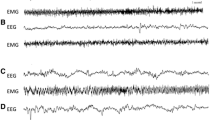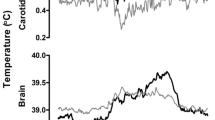Abstract
In rats, brain temperature (T br) and core temperature (T c) were recorded in parallel with the sleep-wake activity throughout the 24-h diurnal cycle, consisting of a 12-h light (L) and a 12-h dark (D) period. In order to characterize the temperature changes associated with the arousal states in the L and the D separately, (i) the average temperatures in wakefulness (W), non-rapid eye movement sleep (NREMS) and REM sleep (REMS), and at the transitions between the arousal states were calculated; (ii) the courses of temperatures before and after the transitions (falling asleep, awakening from NREMS or REMS, transition from NREMS to REMS) were determined; (iii) the rates of changes inT br andT c were calculated for each state; and (iv) the correlations between the temperatures and the overall length of each arousal state, and betweenT br andT c were studied.
In both the L and D periods,T br andT c decreased at the beginning of NREMS, then levelled off, and increased slightly before awakening. Apart from short arousals which did not affect temperature,T br andT c increased in W, peaked 15–20 min after awakening, and declined significantly before the falling asleep. In REMS,T br increased at a high rate, while a slight increase inT c was evident in the L only. Correlations between the temperatures and the arousal states were found in both the L and the D. The courses ofT br andT c were also correlated.
The results support the existence of characteristic changes in body temperature related to the arousal states in the rat.
Similar content being viewed by others
References
Aschoff J (1970) Circadian rhythm of activity and of body temperature. In: Hardy JD, Gagge AP, Stolwijk JAJ (eds) Physiological and behavioral temperature regulation. Charles C Thomas, Springfield, pp 905–919
Aschoff J, Pohl H (1970) Rhythmic variations in energy metabolism. Fed Proc 29:1541–1552
Aschoff J, Von St Paul U (1973) Brain temperature as related to gross motor activity in the unanaesthetized chicken. Physiol Behav 10:529–533
Aschoff J, Daan S, Honma K-I (1982) Zeitgebers, entrainment, and masking: some unsettled questions. In: Aschoff J, Daan S, Gross GA (eds) Vertebrate circadian systems. Springer, Berlin Heidelberg New York, pp 13–24
Berger RJ (1975) Bioenergetic functions of sleep and activity rhythms and their possible relevance to aging. Fed Proc 34:97–102
Borbély AA, Neuhaus HU (1978) Daily pattern of sleep, motor activity and feeding in the rat: effects of regular and gradually extended photoperiods. J Comp Physiol 124:1–14
Czeisler CA, Zimmerman JC, Ronda JM, Moore-Ede MC, Weitzman ED (1980) Timing of REM sleep is coupled to the circadian rhythm of body temperature in man. Sleep 2:329–346
DeCastro JM (1980) Core temperature relationships with spontaneous behavior in the rat. Physiol Behav 25:69–75
Donhoffer SZ (1980) Homeothermia of the brain. Akademia Kiadó, Budapest, pp 17–56
Eastman C, Rechtschaffen A (1983) Circadian temperature and wake rhythms of rats exposed to prolonged continuous illumination. Physiol Behav 31:417–427
Geschickter EH, Andrews PA, Bullard RW (1966) Nocturnal body temperature regulation in man: a rationale for sweating in sleep. J Appl Physiol 21:623–630
Gillberg M, Akerstedt T (1982) Body temperature and sleep at different times of day. Sleep 5:378–388
Graf R (1980a) Diurnal changes of thermoregulatory functions in pigeons. I. Effector mechanisms. Pflügers Arch 386:173–179
Graf R (1980b) Diurnal changes of thermoregulatory functions in pigeons. II. Spinal thermosensitivity. Pflügers Arch 386:181–185
Graf R, Heller HC, Rautenberg W (1981) Thermoregulatory effector mechanism activity during sleep in pigeons. In: Szelényi Z, Székely M (eds) Contributions to thermal physiology. Pergamon, Oxford, pp 225–227
Hammel HT, Jackson DC, Stolwijk JAJ, Hardy JD, Stromme SB (1963) Temperature regulation by hypothalamic proportional control with an adjustable set point. J Appl Physiol 18:1146–1154
Hayward JN, Baker MA (1969) A comparative study of the role of the cerebral arterial blood in the regulation of brain temperature in five mammals. Brain Res 16:417–440
Heller HC, Glotzbach SF (1977) Thermoregulation during sleep and hibernation. Int Rev Physiol 15:147–187
Heller HC, Graf R, Rautenberg W (1983) Circadian and arousal state influences on thermoregulation in the pigeon. Am J Physiol 245:R321-R328
Honma K-I, Hiroshige T (1978) Simulataneous determination of circadian rhythms of locomotor activity and body temperature in the rat. Jap J Physiol 28:159–169
Kawamura H, Whitmoyer DI, Sawyer CH (1966) Temperature changes in the rabbit brain during paradoxical sleep. Electroenceph Clin Neurophysiol 21:469–477
Kovalzon VM (1973) Brain temperature variations during natural sleep and arousal in white rats. Physiol Behav 10:667–670
Mills JN, Minors DS, Waterhouse JM (1978) The effect of sleep upon human circadian rhythms. Chronobiologia 5:14–27
Obál F Jr (1984) Thermoregulation and sleep. Exp Brain Res (Suppl) 8:157–172
Obál F Jr, Tobler I, Borbély AA (1983) Effect of ambient temperature on the 24-hour sleep-wake cycle in normal and capsaicin-treated rats. Physiol Behav 30:425–430
Parmeggiani PL (1984) Autonomic nervous system in sleep. Exp Brain Res (Suppl) 8:39–49
Parmeggiani PL (1977) Interaction between sleep and thermoregulation. Waking Sleeping 1:123–132
Parmeggiani PL, Rabini C (1970) Sleep and environmental temperature. Arch Ital Biol 108:369–387
Parmeggiani PL, Zamboni G, Perez E, Lenzi P (1984) Hypothalamic temperature during desynchronized sleep. Exp Brain Res 54:315–320
Parmeggiani PL, Franzini C, Lenzi P, Zamboni G (1973) Threshold of respiratory responses to preoptic heating during sleep in freely moving cats. Brain Res 52:189–201
Roussel B, Bittel J (1979) Thermogenesis and thermolysis during sleeping and waking in the rat. Pflügers Arch 382:225–231
Stahel CD, Megirian D, Nicol SC (1984) Sleep and metabolic rate in the little penguin, Eudyptula minor. J Comp Physiol B 154:487–494
Valatx JE, Roussel B, Curé M (1973) Sommeil et température cérébrale du rat au cours de l'exposition chronique en ambiance chaude. Brain Res 55:107–122
Walker JM, Berger RJ (1980) Sleep as an adaptation for energy conservation functionally releated to hibernation and shallow torpor. Progress in Brain Research 53:255–278
Wenger BC, Roberts MF, Stolwijk JAJ, Nadel ER (1976) Nocturnal lowering of thresholds for sweating and vasodilatation. J Appl Physiol 41:15–19
Weitzman ED (1982) Chronobiology of man. Human Neurobiol 1:173–183
Wever RA (1983) Organization of the human circadian system: internal interactions. In: Wehr TA, Goodwin FK (eds) Circadian rhythms in psychiatry. Boxwood, Pacific Groove, pp 17–32
Zulley J, Wever R, Aschoff J (1981) The dependence of onset and duration of sleep on circadian rhythm of rectal temperature. Pflügers Arch 391:314–318
Author information
Authors and Affiliations
Rights and permissions
About this article
Cite this article
Obál, F., Rubicsek, G., Alföldi, P. et al. Changes in the brain and core temperatures in relation to the various arousal states in rats in the light and dark periods of the day. Pflugers Arch. 404, 73–79 (1985). https://doi.org/10.1007/BF00581494
Received:
Accepted:
Issue Date:
DOI: https://doi.org/10.1007/BF00581494




